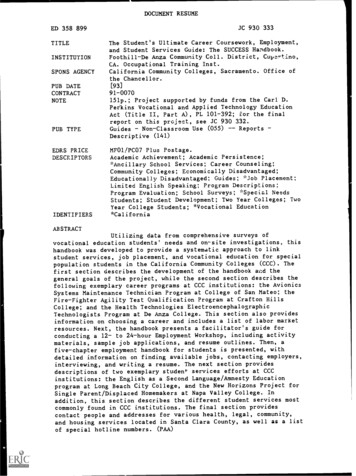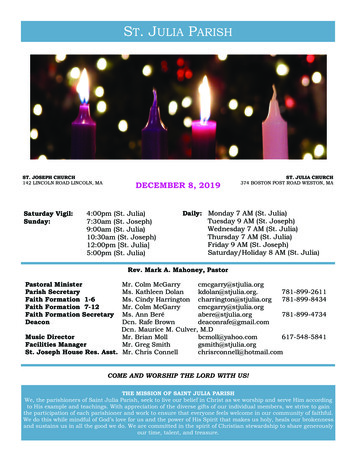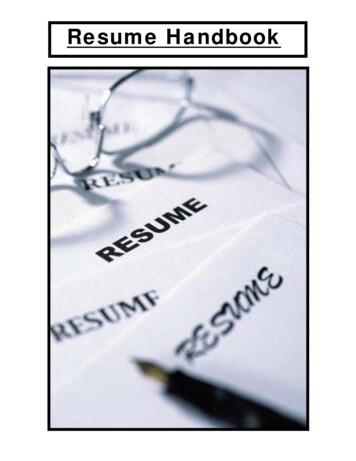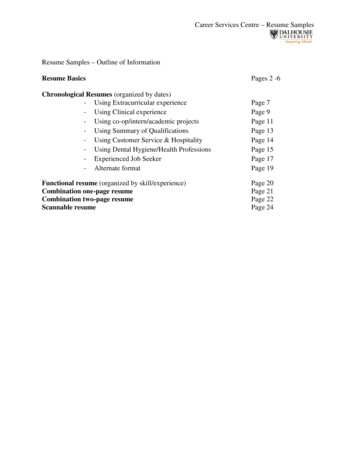
Transcription
DOCUMENT RESUMEJC 930 333ED 358 899TITLEINSTITUTIONSPONS AGENCYPUB DATECONTRACTNOTEPUB TYPEEDRS PRICEDESCRIPTORSIDENTIFIERSThe Student's Ultimate Career Coursework, Employment,and Student Services Guide: The SUCCESS Handbook.Foothill-De Anza Community Coll. District, Cupertino,CA. Occupational Training Inst.California Community Colleges, Sacramento. Office ofthe Chancellor.[93]91-0070151p.; Project supported by funds from the Carl D.Perkins Vocational and Applied Technology Educationor the finalAct (Title II, Part A), PL 101-392;report on this project, see JC 930 332.ReportsNon-Classroom Use (055)GuidesDescriptive (141)MF01/PC07 Plus Postage.Academic Achievement; Academic Persistence;*Ancillary School Services; Career Counseling;Community Colleges; Economically Disadvantaged;Educationally Disadvantaged; Guides; *Job Placement;Limited English Speaking; Program Descriptions;Program Evaluation; School Surveys; *Special NeedsStudents; Student Development; Two Year Colleges; TwoYear College Students; *Vocational Education*CaliforniaABSTRACTUtilizing data from comprehensive surveys ofvocational education students' needs and on-site investigations, thishandbook was developed to provide a systematic approach to linkstudent services, job placement, and vocational education for specialpopulation students in the California Community Colleges (CCC). Thefirst section describes the development of the handbook alld thegeneral goals of the project, while the second section describes thefollowing exemplary career programs at CCC institutions: the AvionicsSystems Maintenance Technician Program at College of San Mateo; theFire-Fighter Agility Test Qualification Program at Crafton HillsCollege; and the Health Technologies ElectroencephalographicTechnologists Program at De Anza College. This section also providesinformation on choosing a career and includes a list of labor marketresources. Next, the handbook presents a facilitator's guide forconducting a 12- to 24-hour Employment Workshop, including activitymaterials, sample job applications, and resume outlines. Then, afive-chapter employment handbook for students is presented, withdetailed information on finding available jobs, contacting employers,interviewing, and writing a resume. The next section providesdescriptions of two exemplary student services efforts at CCCinstitutions: the English as a Second Language/Amnesty Educationprogram at Long Beach City College, and the New Horizons Project forSingle Parent/Displaced Homemakers at Napa Valley College. Inaddition, this section describes the different student services mostcommonly found in CCC institutions. The final section providescontact people and addresses for various health, legal, community,and housing services located in Santa Clara County, as well as a listof special hotline numbers. (PAA)
,I1(S1111e;:g7s .'11 111191111111-. ,5,;.Mb.,\{*,,.-'"/if.,A . "."' . .,4.?, :KW."' ' ."te./z, /2st.ee7)01.kaMakl74%- 4 , 011***II111111'i.,. 4/***AgeviI I*Allt;"coIY4dim,./ ;.".;iisiiii iiiiiiiiiiiiiip,'4.'".:/,'.,,,/741 ovf#1%we/a's,. . '% b" , :. t''' y .Ewmi. ' aLa.k'4. , ././.S:pri/. is4,W:1,1, .:.".%%.',.),.?",,,?."/. 4.,:0Va5:'.}1;';;".s-.:02;1's'''.Aw;,,n e",'"Iw tf-V,KeN pg.(AA,I,o;lI II1IIIosse,III'Y,/W.itr.?/i1.;
The a tudent's A.I ltimate C areer C oursework,lEmployment and tudent cervices GuideThe SUCCESS HandbookThis report is made pursuant to contract/agreement number 91-0070. This projectwas supported by the Carl D. PerkinsVocational and Applied TechnologyEducation Act Title II, Part A. P. L. 101392, funds administered by the Chancellor'sOffice, California Community Colleges."The activity which is the subject of thisreport was supported in whole or in part bythe U.S. Department of Education.However, the opinions expressed hereindo not necessarily reflect the position orpolicy of the U. S. Department of Education,and no official endorsement by the U. S.Department of Education should beinferred".Prepared for theEconomic Development and Vocational Education DivisionCalifornia State Community College Chancelor's Officeby the Occupational Training InstituteFoothill-De Anza Community College District21250 Stevens Creek Blvd., Cottage #2Cupertino, CA 95014
The SUCCESS Handbook was created by:Karen Johnson, Project Co-DirectorSpecial Grants SupervisorOccupational Training InstituteThe SUCCESS Handbook staff included:Project Director: Maria C. Banatao, DirectorOccupational Training InstituteFiscal Coordinator: Coral Clark, Assistant DirectorOccupational Training InstituteSecretary: Christine Spence, Program AssistantOccupational Training InstituteThe Success Handbook Staff would also like to thank the members ofThe Success Advisory Committefor their valuable assistance in the development of this publication.Jeanette DannaSan Jose City CollegeCareer Planning & PlacementEvelyn PattersonContra Costa CollegeCareer Planning & PlacementRosa PerezSkyline CollegeCounseling DepartmentJoyce BlairCollege of AlamedaCareer Planning & PlacementFred KritchfieldFoothill CollegeDirector of Economic Development DepartmentElaine BurnsCollege of San MateoCareer Development CenterShirley KawazoeDe Anza CollegeCareer Planning & PlacementWilliam Dabney, Assistant DeanContra Costa CollegeOccupational & Technical ServicesKim PetersenDe Anza College Occupational Training InstituteGain CoordinatorRuth McMullenHartnell CollegeDirector of Students Developmental ServicesPeggy O'NeillDe Anza CollegeCareer Planning & PlacementLarry MuellerGavilan CollegeCareer Planning & PlacementJacqi DavisMonterey Pennisula CollegeCounseling DepartmentKristin BillbeckVallco Fashion Park, Marketing DirectorDr. Michael SullivanDe Anza CollegeDean Instruction Career & Technical EducationJohn ChristensenContra Costa CollegeCareer Planning & PlacementGary PruittRepresentative of the Central California DistrictCouncil of Carpenters, Nova PIC MemberClyde E. AlbertLockheed, Non Exempt StaffingNancy JohnsonChild Care Representative, Silicon Valley PIC
1Table of ContentsPagestudent's UltimateProject Overview1Career CourseworkCOLLEGE OF SAN MATEOAvionics Systems Maintenance Technician ProgramCRAFTON HILLS COLLEGEFire-Fighter Agility Test Qualification ProgramDE ANZA COLLEGEHealth Technologies Electroencephalographic Technologists ProgramHOW TO CHOOSE A CAREER5101216lEmploymentEmployment Section Background21Facilitators Guide22Student Employment Handbook(This section is numbered separately for reproduction)42student servicesLONG BEACH CITY COLLEGEESL/Amnesty Education ProgramNAPA VALLEY COLLEGENew Horizons Project for Single Parent/Displaced HomemakersACCESSING STUDENT SERVICES435054COMMUNITY SERVICESHealth Services61Legal Services63Community Services64Housing Services67Hotlines68
:. rstN441APWHY A SUCCESS HANDBOOK?All providers of vocational training programs are faced with the prospectthat a percentage of there vocational training students will drop out oftraining primarily due to the lack of support services. In addition, some oftheir students will be unable to secure employment in their chosen careerfield. Retention and placement of students completing vocational educationprograms is increasing in importance and there is a genuine need to identifycommon obstacles within this special needs population and to find ways ofassisting those participants who are inadequately served or underrepresented.Coordination of vocational education instructional programs, student,services and job placement is vital to the success of these students as wellas the overall success of the program. This innovative project wasconceived to address the needs of students who are members of specialpopulations and to provide a systematic approach to link the critical areasof student services, job placement and vocational education.s,Z)," lk ","3.4",k 45,.ckk.e.,kkr.%,"s The Student's Ultimate Career Course work, Employment and StudentServices (SUCCESS) Handbook project offers a multi-level approach toaccess support services available through the Community Colleges toincrease student retention and to identify common barriers to employmentwithin this population and to develop ways to overcome them. It will bet.7;. "atdesigned to prepare students for employment in existing, new and emergingoccupations, assist students in making occupational choices, improveplacement of students who have gained vocational skills and to assist thosealready employed in the development of new skills to advance or changeemployment fields. This project's primarily focus is on the needs ofvocational education students with handicaps, who are educationally andeconomically disadvantaged, who have limited English proficiency and/orwho participate in programs designed to eliminate sex bias.Through comprehensive surveys and on-site investigation, existing serviceswere explored and methods used to successfully motivate special populations Ws,ikk.".%":;',2&"kof students towards education and employment were documented. Theresults were incorporated into the SUCCESS Handbook to streamline theaccessibility of student services on campus, services available within thecommunity, attainable placement objectives and a systematic approach toemployment services, job search and job retention.The SUCCESS Handbook was designed to improve access to qualityvocational education for special needs populations and ensure equal accessto vocational programs. The information in the SUCCESS Handbook canbe duplicated and incorporated into other college programs state-wide toenable all students to be successful in the transition from school to work.COPY AVAILABLE" "'/ 4V's"skk2/is.::', .::,'.!: ::rC"."tk,.kz " :i, .:,,,::',.:.::,.s. s , ke,' st::"., I.s,,k
The Success Handbook was created by the Foothill-De Anza OccupationalTraining Institute (OTI). 011 was founded in 1975 as a cooperative effort"-A between Sunnyvale CETA Prime Sponsor and Foothill-De Anza CommunityCollege District to provide Vocational Training and Job Placement to theunemployed under the CETA Act. Since its inception, OTI has providedservices to over 15,000 residents of Santa Clara and San Mateo counties.Grant funds received by 011 in the past 18 years are: CETA, Chancellor'sOffice Investnent in People Project and Employer-Based Training funds,State Displaced Workers Project, JTPA Title II -AB, Title HI, TargetedAssistance for Refugees (TAP I, II, HI, IV, V, VI, VII and VIII), CWETA,ETP, SECG and GAIN.11P::;Z,E.5c7.i onnmOTI, through the various programs it has implemented, has developed theexpertise in adapting programs to the immediate needs of its participants. Thebottom line is to provide each participant an avenue for future growth throughquality vocational education and a clear understanding of employmentstandards and career advancement. This is evident in our programs throughthe success and job growth of OTT graduates."4.The Foothill-De Anza Community College District has been selected as oneof the five best colleges in the country and California's best. It has been in theforefront of developing outstanding vocational curriculum, innovative studentservices and implementing successful programs for the last 30 years.;it, As',.x.**:k,s.:N ON'S.;".;."\"'"Vs.\*1" ZGoals of the SUCCESS Handbook Project: 1;.43. 4*Survey job placement, student services and vocational educationinstructional programs on all 107 community college campusesthroughout the state of California.*Evaluate existing services and programs and identify the areas of mostneed in reference to the special population student.*Establish new curriculum and methodology to improve the completionand the employment :ate of existing vocational education programproviders within the community college system and incorporate it inthe SUCCESS Handbook.;.\'kkx§3:Evaluate new curriculum and methodology.Develop a resource manual to be made available to all communitycolleges that illustrates the linkages between college departments andvocational education programs as well as the best approaches to use inserving this population of students.*Dissemination of the SUCCESS Handbook for replication in othercommunity colleges.2
How The SUCCESS Handbook Was DevelopedTo insure a diversity of opinion was reflected L., this project a SUCCESSAdvisory Committee was formed consisting of members from these areas:North Valley Job Training Consortium Private Industry CouncilJTPA Balance of County Private Industry CouncilApplied Science DivisionsTechnical/Vocational Education DivisionsCounseling DepartmentsCollege Economic Development DepartmentsCollege Learning CentersCareer Planning and Placement CentersSpecial Education ProgramsSanta Clara County Community College Consortium for GAINLabor Union RepresentationThe SUCCESS Advisory Committee met on a quarterly basis during theproject and made recommendations concerning the project's plan ofaction. In addition the Committee acted as an advisor to the developmentof the project information. The Advisory Committee was instrumental inthe selection of exemplary programs to be included in the Handbook. ,A11107 California Community Colleges were surveyed to identify areas ofvocational student need. A questionnaire was developed with the assistanceof the SUCCESS Advisory Committee. From the initial survey, fiveexemplary programs were selected to be incorporated into the Handbook.In addition, 100 special needs vocational education students were surveyedduring their first quarter in training. These students were identified with thehelp of the Santa Clara County Community College Consortium for GAIN.:;:::::kkaA questionnaire was developed with the assistance of the SUCCESSAdvisory Committee to identify the students areas of concern andrequirements for assistance. Results were incorporated into the Handbook.Also, special needs vocational education students who have completedvocational training and are either seeking employment or who have startedworking were surveyed as to the participants perception of training quality,appropriateness, student services availability and placement assistance.During these difficult financial times, special needs students often needservices that are not available through the college. As part of the researchfor this project the availability of support services within the communitywere explored, documented and included to assist program providers withadditional rescources for suport services.utST COPY AVAILABLEs ss.:.,,,:e;?.4::/s,\rsSs.s
3 :;k,'"Short Term OutcomesTo provide a Handbook that would assist special populationstudents to achieve their educational and vocational goals bypresenting the availability of support services in an easy to useformat.*Establish linkages between the various student services, jobplacement activities and vocational educational programs on thevarious California Community College campuses.Long Range OutcomesTo increase the success rate of special populations in achievingtheir educational and vocational goals.*Promotion of future linkages between industry, the communitycollege, student services and job placement activities.The continued evaluation of the success of the Long Range and Short TermOutcomes will provide further information to develop stronger linkageswithin the various Departments of California's Community Colleges. Thiswill be essential as the needs of special populations become greater andeducational funding decreases.This Handbook- was developed with these goals in mind. While this book doesnot offer the perfect road map to a successful program, it does offer someexcellent examples of what has worked with specific special needs populations.The programs selected are in the areas of Career Coursework and StudentServices.If anything is to be learned from this project, it is that innovation andflexibility are essential to success. Each special population has its ownunique needs that must be addressed if they are to be successful in oureducational system and in the world of work. Strong support systems mustbe established for positive outcomes to take place.It is hoped that the information found in these pages will inspire you to lookat the possibilities abundent within your institution for innovative creativeprojects. The staff of the SUCCESS Handbook hopes you find this publicationinformative and helpful in your search for excellence in vocational education.BEST COPY AVAILABLE4
(The student's 'Ultimate CareerCoursework, 'Employment and studentServices Handbook)
COLLEGE OF SAN MATEOAVIONICS SYSTEMSMAINTENANCETECHNOLOGY:., ;:.*%.'s-,.;'vzw's,-Avionics is the application of electronics to aircraft systems: includinginstrumentation, navigation, control, communication, and power planttechnologies. Almost all of the operation of new aircraft-once managed withmechanical, electrical, pneumatic, and hydraulic systems-now function witha combination of electronic and computer technologies called "Avionics".The project identified that mechanics (technicians) with Avionics knowledgeand skills were currently in short supply. Bay area labor market projectionsw.tiindicated that these shortages will continue to grow concurrent with theexpansion of commercial airline services and their use of state-of-the artaircraft.The need for mechanics with Avionics skills was especially critical at majorairline maintenance facilities. Such facilities included those at the SanFrancisco International Airport (SFO) that is being served by the College ofSan Mateo (CSM). United Air Lines (UAL), the major employer involved inthe project and major employer at SFO, has a substantial impact on San MateoCounty's employment and economic strength. In addition, several majorairlines have SFO as a hub with major routes both domestic and international.ehMO,4-118.5P:kIn the Spring of 1990 College of San Mateo (CSM), in response to the SanFrancisco Bay Area's air transportation labor needs, proposed and wasfunded to develop and implement an Avionics Systems MaintenanceTrainingProgram is a two year certification program. This project was funded underthe California Chancellor's Office Ed Net Employer -Based Training Funds(EBT) for Phase I in 1990-91 and Phase II in 1991-92.Through the cooperative efforts of UAL,. Federal Aviation Administration(FAA) and CSM representatives, the Avionics Mechanics training wasplanned, developed and implemented to meet the updating needs cf currentpersonnel and expansion plans of UAL and other SFO airlines. The UAL SFOz.".tkMaintenance Base (SFOMB) is the largest and most diverse of UAL'sfacilities throughout the world. It includes complete facilities for maintenanceand overhaul of modern commercial aircraft and related systems.Mechanic employment at the UAL SFOMB in 1990 was over 7200, up form5800 in 1988, with a projected growth and demand for qualified mechanicsfar exceeding their supply. UALS's projections in 1990 was for the employmentof over 1800 maintenance workers in the next three years. This wasS.5.1":k5,Z;ss, ','4 s's?!;ssA 4substantiated by EDD's labor markets research of 1989.ss,?;55%;s'ts 4"AVIONICS LINKAGESThe College of San Mateo in response to a unique opportunity proposed forEBT funds to develop the Avionics program - combining the capabilities oftwo Technology Departments-Aeronautics and Electronics. This combinationBEST COPY AVAILABLE5'"",::.ss,sv.
of interdepartmental capabilities provided the College a "running start" inestablishing a new program in a new and emerging technology field.;"Sssk ,,t,:cWith the partnership already established between United Airlines and Collegeof San Mateo, and support of EBT funds, CSM under Phase I had theopportunity to provide the first-year sequence of Avionics courses in place forSeptember 1990. The EBT funding prov' ed the critical "seed money" toestablish the two-year curriculum and proceed with the upgrading andcertification of new Avionics mechanics.The College began the process of adapting their Aeronautics and ElectronicsCurricula, in consultation with their Aeronautics Advisory Committee andexperts at the United Air Lines Maintenance Base. The curriculum designedincluded (1) upgrade opportunities for those employed in thefield and in needof retraining and (2) those who were just entering the filed. The developmentalaspects of the project started with regular advisory committee meetings in1989. UAL managers and the Aeronautics Advisory Committee approved thestructure, and agreed in the developmental process for the new Avionicsprogram.With this training not available at any other Northern California publiceducational institution, CSM has a unique opportunity to innovate and assistthe aviation industry in the area. The project was to serve as amodel for othercolleges who needed to meet the needs of airlines with current "hubs" and/orestablishing new" hubs" in their area.The Avionics Systems Maintenance training program is a true model foreconomic development involvement of a community college in California.By the end of Phase I, June 1991, the College developed the two yearcurriculum for the Avionics training program that met the requirements forFAA and FCC licenses. In phase I, the College also successfully implementedthe first phase of training.The advisory committee, the United Airlines management and CSM staff,V, was structured to address three aspects of the program-structure, curriculumand course content. Meetings were conducted monthly during the FallSemester and twice monthly during the Spring Semester.United Airlines, as represented by Mr. Lou Gusto, UAL' s manager responsiblefor mechanic employment, was continuously involved with the program fromits inception. Under Mr. Gusto's guidance, CJM was able to establish theAirframe and Avionics FAA/FCC qualification structure that would qualifythe program graduates. He helped define union contract agreements and theirimplications for qualifying the students who w.11 seek employment in theindustry.Although UAL did not send employees to attend the first year courses offeredduring Phase I, UAL established a strong network of contacts in the various:"!zs:itedepartments within the UAL corporation. These departments providedguidance and access to instructors and included employment, training,maintenance, and the media/instructional materials departments. The firstphase focused its offerings to entry level students who will be seekingemployment in the field. UAL employees were planned to participate in thesecond phase of the project.FAA certification of the Airframe and Avionics programs was pursuedthrough the Aeronautics Department. Since the A & A closely complies withthe FAA general subjects courses already approved by the FAA, they onlyrequested a letter of intent to which they responded favorably./".BEST COPY AVAILABLE6
1 MIIM1 The College enrolled over 624 students in Fall and 614 students in SpringSemester (Total enrollments in each class, some students may be countedmore than once if enrolled in two or more classes). These courses contributedover 50% in ADAJFFEs revenues for the departments.CURRICULUM DESIGNThe curriculum designed and developed with the assistance of UAL and theAvionics Advisory Committee was a five semester certification program. Atthe end of the first year of implementation, the first two semesters wereoffered. The first year of training (phase I) was primarily targeted for thosewho are entry level trainees in entering the field of Avionics. Those whosuccessfully complete the five semesters of training would qualify for FCClicense certification.The curriculum developed and completed were to prepare mechanics tomaintain modem aircraft equipped with avionics systems. The coursesincluded basic courses.that emphasize an understanding of electrical, electronic,and computer fundamentals and advanced courses that apply thesefundamentals to the operation of aircraft systems.The courses are structured to comply with existing FAA requirements for theAirframe Lincense; then augmented with the specialized electronics contentto obtain an FAA License by examination. Additional course materials areincluded in computer technology to further qualify students for work onaircraft. All people who work on modern aircraft systems need to qualify theirskills and knowledge of electrical and computer fundamentals. Thus allcurrent and prospective students, and all employed aviation mechanics areprobable candidates for the Avionics program.The College did develop and enhance on-going partnerships with UAL andother commercial airlines through the Industry Advisory Committee. Otherairlines were informed of the project. They endorsed the concept and programdirection and are planned to participate in the second phase of the project. Dueto staff limitations, it was difficult to extend CSM's efforts into othercorporations during phase one.UAL provided assistance to the Program through equipment donations, andadvisory and technical consultation. A total of 105,000 in in-kind contributionand 135,000 in equipment donation can be attributed to the project throughthis cooperation between CSM and UAL.UAL assisted thit College in its recruiting efforts, including cooperation withpublic pr in.; media and internal communications media; announcingemployroP,nt ssrd upgrade opportunities available through the program.INTER-COLLEGE SUPPORTThe evolution of the Avionics Program required instructor qualification,especially for the advanced Avionics courses. Avionics, involving computersand electronics systems is a new technology. Instructor qualification involvedextensive communication between CSM's Aeronautics A & P and theElectronics faculty. The expertise and qualification brought in by bothdepartments' faculty helped make the project successful.The cooperation of UAL's staff in the staff development of CSM faculty andIdvanced curriculum for the program remains to be of vital importance andwere the backbone support of the project. Without the cooperation of UAL,7\ 5214%\'
curriculum and staff development would have extended to several years.As a match to the grant received, the College awarded two Trustee's projectsto faculty members, Mr. Roy Brixen and Mr. Bob Kellejian. These projectsdirected these faculty to qualify themselves for Avionics instruction; awarding60% reassigned time for one semester to complete their projects.The project's outreach for involvement of disadvantaged, minorities, andwomen in the program used the valuable network of recruiters from theCollege's Extended Opportunity Programs and Services (EOPS). EOPSpmvidt.d the development and dissemination of project brochures, newsletters,recruitment and outreach efforts, and authorized public service announcementsover KCSM television and radio. Extensive recruitment and outreach weredone at local and nearby schools. Newspaper write-ups such as the San MateoTimes provided publicity for the program in the community.ADDITIONAL FUNDINGTen thousand dollars was received from the Radcliffe Fund, an endowmentestablished at CSM, to support instruction in electronic communication. Thisfund provided support to qualify instructors in learning new technologies andprovide equipment for the labs.The Len and Charlotte Erickson Foundation donated 85,000 to CSM. Thisdirectly funded the study, acquisition, and implementation of technicalinstruction using networked computers.PITFALLSThe inadequate progress identified in the project for phase I was the lack offollow-up on students who drop out of the program. No systems at the collegeis currently available to provide the student follow-up. These systems shouldbe developed and integrated into the program to allow for the follow-up ofthose who do not make it in the program. This form of on-going evaluationwill enhance program success. Additional services and/or support can beidentified to assist those who have personal and academic r .oblems.Although the current economy did not allow for extensive growth as originallyprojected, there are still opportunities for entry-level employment of programgraduates. Upgrading of current workforce under Phase II will be of criticalimportance to the survival and productivity of the aviation industry's workforce.Speakers were invited from United Airlines and Northwest Airlines to advisestudents about employment qualification and future career opportunities.Due to poor economic conditions at the present time, job opportunities havenot opened up as projected by labor market projections of 1989-91. Californiahas suffered a tremendous amount of unemployment due to the displacementsin the large manufacturing plants who have government contracts. Althoughno displacements have occurred in the San Francisco UAL hub, positionshave become more competitive. Due to the slow-down in the economy, UALand most other airlines have also put a hiring freeze on new hires.A MODEL PROGRAMThe partnership between United Airlines and the College of San Mateo's ;s;:r.f.,8
newly developed Avionics Systems Maintenance continues to strengthenunder Phase II. Mr. Lou Gusto, HRD manager has continually marketedthe program model to other UAL facilities and their respective locality.Visits were made by several state agencies, UAL branches and both twoyear and 4 year universities to emulate the College of San Mateo program.Colleges that visited with the College of San Mateo staff were from thestates of Virginia, Indiana, North Carolina and Florida; Mr. Bob Kellejianhas been invited by UAL to speak with several State agencies to providesome insight into establishing an Avionics program. These states wereArizona, Texas and Oklahoma.t Ns.The Avionics Systems Maintenance Technician is a highly successfulmodel of a partnership between a community college and the private sector.The cooperation and participation of United Airlines in the planning,development and implementation of the project was a critical facto
San Jose City College Career Planning & Placement. Rosa Perez Skyline College Counseling Department. Fred Kritchfield Foothill College Director of Economic Development Department. Shirley Kawazoe De Anza College Career Planning & Placement. Kim Petersen De Anza College Occupational Training Institute Gain Coordinator. Peggy O'Neill De Anza College










